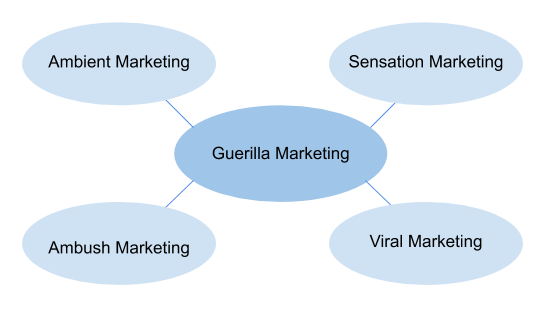Definition
Guerrilla marketing is an unconventional approach to advertising which mostly depends on the element of surprise to attract the consumers’ attention. The term was introduced to the marketing lexicon by Jay Conrad Levinson through his book Guerrilla Advertising which was published in 1984. The advertising technique was named after guerrilla warfare tactics which utilized unconventional strategies such as ambushes, acts of sabotage, and surprise raids. Guerrilla warfare was preferred by the ‘underdogs’ in a conflict who were facing better trained, better equipped, and in some cases, a numerically superior opponent.
The main goal of a guerrilla marketing strategy is to evoke an emotional response from a consumer due to the unconventional nature of the ad. This makes the marketing content more memorable to those it interacts with. It also creates ‘buzz’ as people talk about the campaign and the brand behind it. Particularly inventive and effective guerrilla marketing campaigns usually attract media coverage, which adds to the buzz. It is an effective form of below-the-line communication which does not depend on mainstream media but relies on direct customer interaction.
Types of guerrilla marketing
There are four main types of guerrilla marketing that overlap to some extent and cannot always be clearly distinguished from one another. These include ambient marketing, ambush marketing, sensation marketing, and viral marketing.

Figure: Types of guerilla marketing, Author: Seobility
Ambient marketing
Ambient marketing is all about placing advertisements in unusual or unconventional spaces. Imagination is the only restriction when it comes to ad placement. Both indoor and outdoor spaces can be effectively utilized in ambient marketing. As with all forms of guerrilla marketing, the marketing content also has to be unconventional to hook the customer’s attention. It is vital to place your advertisement in an area that is regularly trafficked by the type of consumers your brand is targeting. Since your ad will be in an unusual space, you need to ensure that it can attract the attention of passersby effectively. An example of ambient marketing is this bench, placed by KitKat:

Post about a bench placed by KitKat on Twitter.com
Ambush Marketing
Ambush marketing is an aggressive – often confrontational – guerrilla marketing strategy that involves a brand marketing its products in the same place another company (usually a direct competitor) is marketing its products. This usually occurs during large sporting events where a brand that is not an official sponsor uses ambush tactics to promote their brand against a competitor’s official marketing measures. It requires a lot of creativity to come up with a creative out-of-the-box ambush marketing idea that will upstage a competitor’s advertising.
Sensation Marketing
Also called ‘hit and run’ marketing, it is a guerrilla marketing strategy that aims to evoke unusual sensations from a familiar environment. The best example of sensation marketing is the flash mob. These are individuals that break out in a choreographed performance in public spaces such as sidewalks and malls. The unusualness of the action in the given environment leaves a lasting impression on any potential consumer exposed to your brands marketing efforts through sensation marketing.
Viral Marketing
Viral marketing is probably the most recognized form of guerrilla advertising due to its use of online communication channels such as social media. The aim of this type of advertising is to create content that is both interesting and engaging. Such content – if all goes well – will be shared widely from person to person making it ‘viral’.
Success factors
There are many factors that determine the success of your guerrilla advertising campaigns. The most important of these has to be finding a creative and unique idea for your brand’s advertisement content. Guerilla advertising is all about attracting and retaining your customers’ attention. An effective guerrilla campaign requires adequate planning. This has to involve guerrilla marketing experts in decision-making positions to get the logistics right.
As with any other form of advertising, the goals of the campaign need to be clearly defined beforehand. This includes the metrics through which success will be defined. Understanding the target audience is extremely important for guerrilla advertising. Since the presentation and content of the campaign will be unconventional, a brand needs to ensure that it will attract and engage the right type of customer. The messaging also has to be consistent with the brand identity cultivated by a business. Lack of coherence between advertising messaging and how the brand is perceived by consumers in the market is something to be avoided.
Your business’ campaign has a higher likelihood of success if it involves the customer. Customer involvement makes your clients identify with your brand/products on a personal level. Not only will this cultivate brand loyalty, but they will also act as unpaid brand ambassadors within their spheres of influence.
It is also important to note that at its core, guerilla advertisement is all about the element of surprise. There should be no prior announcement; it has to be a surprise. This shock factor is what contributes to the effectiveness of guerrilla tactics in advertising. A well-coordinated guerrilla advertising campaign should involve multiple channels. Press interest should be encouraged as it spreads your brand awareness throughout your target market more effectively. It also lends some credibility to your brand, especially if you are a smaller unestablished brand getting coverage from renowned media entities.
Legal restrictions
The effectiveness of guerrilla marketing comes from its unconventional approach and the element of surprise. The unusual strategies involve can however be disruptive, and in some cases, this could be in direct violation of local laws. The planning stage of any guerrilla advertisement campaign should involve going through local laws and ordinances and determining whether a business will require permits or special permission from local authorities to hold their campaign.
Under no circumstances should an unconventional advertising strategy involve the damage of property. They should also not disrupt personal rights. For certain guerrilla strategies such as ambush marketing, a business needs to be careful to infringe on another brand’s copyrights. It is prudent to always involve a lawyer in the planning stage to ensure your business is not being exposed to unnecessary legal risks.
Related links
- https://www.shopify.com/blog/116564869-5-low-cost-guerrilla-marketing-tactics-to-grow-your-business-offline
- https://creativepool.com/magazine/inspiration/26-creative-guerilla-marketing-examples.2313
